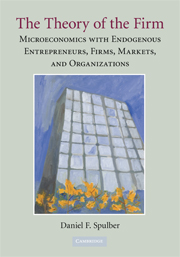 The Theory of the Firm
The Theory of the Firm Book contents
- Frontmatter
- Contents
- Preface and Acknowledgments
- Introduction
- PART I THE THEORY OF THE FIRM
- PART II THE ENTREPRENEUR IN EQUILIBRIUM
- PART III HUMAN CAPITAL, FINANCIAL CAPITAL, AND THE ORGANIZATION OF THE FIRM
- PART IV INTERMEDIATION BY THE FIRM
- PART V MARKET MAKING BY THE FIRM
- 12 Conclusion
- References
- Author Index
- Subject Index
12 - Conclusion
Published online by Cambridge University Press: 05 June 2012
- Frontmatter
- Contents
- Preface and Acknowledgments
- Introduction
- PART I THE THEORY OF THE FIRM
- PART II THE ENTREPRENEUR IN EQUILIBRIUM
- PART III HUMAN CAPITAL, FINANCIAL CAPITAL, AND THE ORGANIZATION OF THE FIRM
- PART IV INTERMEDIATION BY THE FIRM
- PART V MARKET MAKING BY THE FIRM
- 12 Conclusion
- References
- Author Index
- Subject Index
Summary
The Theory of the Firm provides a general framework for introducing institutions into microeconomics. Firms, markets, and organizations arise endogenously through the optimization decisions of economic actors. Individuals choose to become entrepreneurs and establish firms. In turn, firms create and manage markets and organizations. These institutions are part of the economic equilibrium and their features depend on the preferences, endowments, knowledge, and transaction costs of individuals. Microeconomics with transaction costs and endogenous institutions offers a more complete picture of the economy.
The Firm
The general theory of the firm presented here offers a formal method of identifying what is a firm. The separation criterion asks whether the objectives of an institution can be separated from those of its owners. The firm is a transaction institution whose objectives are separate from those of its owners. The separation of objectives provides the basis for profit maximization by firms. The separation of objectives supports the development of financial markets that allocate ownership of firms and corporate control.
The separation criterion offers a bright line distinction between the firm and the many types of consumer organizations that also engage in economic transactions. Consumer organizations include clubs, merchants' associations, exchanges, buyers' cooperatives, workers' cooperatives, nonprofits, basic partnerships, and public enterprises. These organizations are not firms because their objectives are closely tied to the consumption or production interests of their members. For example, a club's objectives are to provide for the recreation, social interaction, cultural development, or other interests of its members.
- Type
- Chapter
- Information
- The Theory of the FirmMicroeconomics with Endogenous Entrepreneurs, Firms, Markets, and Organizations, pp. 458 - 464Publisher: Cambridge University PressPrint publication year: 2009
- 1
- Cited by


